Don't wanna be here? Send us removal request.
Photo

Adapt to this selling cycle 'Selling' seems stiff to a lot of individuals who are trying to make it on their own. With such curated content, I aim to help beginners and people who await a positive change. Hope you found this post useful! 😇 Follow @crafxstudio & @phakkain for more content like this! #marketing #marketingdigital #marketingstrategy #marketingtips #marketingagency #nlp #nlppractitioner #nlpcoaching #kind #kindness #kindnessmatters #brand #branding #brandingquotes #brandingdesign #brandinginspiration #brandingagency #brandingstrategy #brandingtips #brandingstudio #graphicdesign #graphicdesigner #graphicdesigners #graphicdesigns #contentcreator #contentmarketing #contentcreators #contentstrategy (at Cycle) https://www.instagram.com/p/CJ56jdIlWZm/?igshid=1fn7gzpu41kbz
#marketing#marketingdigital#marketingstrategy#marketingtips#marketingagency#nlp#nlppractitioner#nlpcoaching#kind#kindness#kindnessmatters#brand#branding#brandingquotes#brandingdesign#brandinginspiration#brandingagency#brandingstrategy#brandingtips#brandingstudio#graphicdesign#graphicdesigner#graphicdesigners#graphicdesigns#contentcreator#contentmarketing#contentcreators#contentstrategy
0 notes
Text
The 6 Best Social Media Platforms For Your Business in 2021
Some of the best social media platforms for business, like Facebook and Instagram, have become essential tools in the modern marketer’s toolbox.
More and more consumers are using these channels to find new companies and engage with their favourite brands. However, most companies can’t be everywhere at once, especially small businesses with tight marketing budgets. That’s why it’s vital for businesses to be strategic about which social media platforms they work to build a presence on.
The key to successful social media marketing will be choosing the best social media platform for your business. This is based on a number of factors, including the type of business you have, what audience you are trying to reach, your specific goals, and much more.
Below, we’ve put together a quick and simple guide to choosing the best social media for business in the new year.
1. Facebook
2. Instagram
3. LinkedIn
4. Twitter
5. Pinterest
6. YouTube
How to Choose the Best Social Media Platforms for Your Business
Before we start listing the best social media platforms, it is important that you know we curate such content often connect with us for more!
Here are the 3 biggest things you need to keep in mind.
#1 Choose Social Media Platforms Where Your Audience is Located
In order to choose the best social media platforms for your business, you need to understand your customers. Specifically, you need to understand who they are and how they spend their time online.
Ask yourself:
• What social media platforms are they using?
• Why are they using those social media platforms?
• How do they prefer to receive information about your type of products and services?
If you do not already know this, then we recommend mapping out a customer avatar first.
A customer avatar is simply an outline of your customer demographics, goals, preferences, challenges, and other psychographics.
The more you understand your customer, the better you can select the best social media platforms to reach and engage them.
#2 Choose Social Media Platforms That are Specific to Your Content Type
There are two types of content – macro content and micro content.
Macro-content is BIG-picture, long-form content. The 3 different types of macro content consists of Video, Audio, and Written content.
Therefore, if you have macro content, the best social media platforms to publish that content would be YouTube for video content, Apple Podcasts for Audio, and WordPress for long-form blog content.
Micro-content, on the other hand, is short-form, easy to digest content. Think of micro-content like the pictures you find on your Instagram feeds while you’re scrolling, or short witty tweets on Twitter.
Now, there are several different types of micro-content social media channels, like Instagram, Facebook, Pinterest, and so on.
So, in order to choose the best social media platforms for your business, you need to pick the ones where your audience is located.
Also, when it comes to Macro vs Micro content, you should keep in mind that Macro content has a much longer shelf-life than Micro content.
For example, a single blog post that we published has been generating 300-400 views per day at LYFE Marketing.
If people continued to search for that all year, that single blog post would drive over 100,000 views in 1-year’s time.
Whereas a single Instagram post would be here today and gone and forgotten tomorrow. But at the same time, this content is much easier to create and push-out on a consistent basis.
So keep this in mind as your choose which social media platforms you want to specialize in.
#3 Limit the Number of Social Media Platforms You Choose to be On
Don’t spread yourself too thin by trying to be on every single social media platform that exists.
Each social media platform is like an art. You should master the art of 1-2 social media platforms before you consider adding more to your strategy.
It’s not necessary to be on every platform in the world. Facebook has 2 billion users. Instagram has 1 billion users. If you can do just one of these platforms very well, then you can have astronomical business results.
It takes a lot of work and money to develop a successful presence on these social media platforms. It’s not as simple as setting up a profile and pressing “publish” on a post.
No, in most cases, you will need to set aside some money to promote your content. In addition, you’ll need to review the analytics to determine if your content is effective or not.
So in short, as a small business with a limited budget, put all of your eggs in 1 or 2 baskets max to start. Then, consider expanding into other channels.
Alright, so that’s the criteria you need to keep in mind as you select the best social media platforms for your business.
Now, let’s go over some specific platforms to help you choose the best platforms for your business.
Here are the Best Social Media Platforms for Business
Platform #1: Facebook
Facebook is not the newest and coolest social media platform.
But the fact is that it is still the largest social media platform by far in terms of users.
It has over 2 billion monthly active users!
To know more about this in depth join our page!
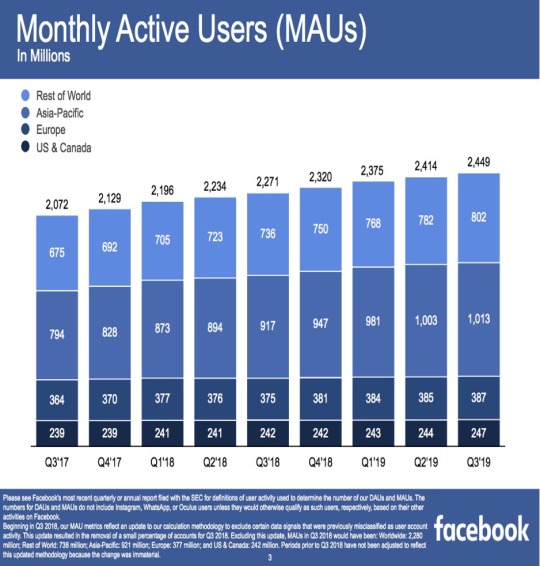
3/4 of Facebook users visit the site on a daily basis. Half of Facebook users visit the site several times per day.
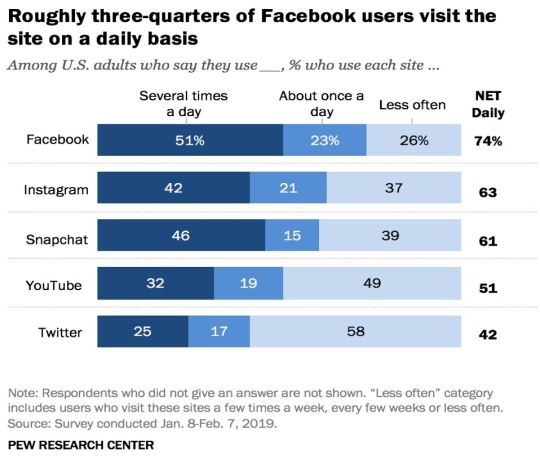
Oh and if you thought teenagers aren’t using Facebook, think again. Over half of teenagers use Facebook. And nearly half of people above the age 46 use Facebook!
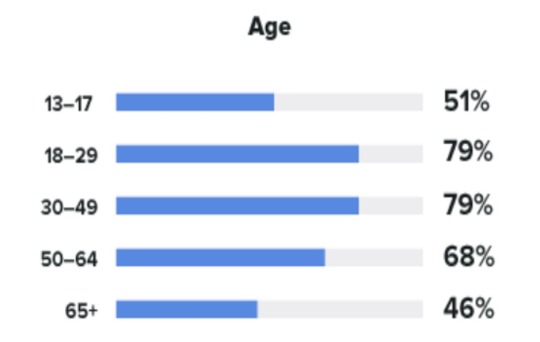
A better question would be, who doesn’t use Facebook?
Here’s a counterargument we hear a lot from our clients.
“I am targeting a high-income, highly educated, professional affluent audience. I don’t want to advertise on Facebook. How about LinkedIn?”
Well here’s the truth – According to Pew Research, 74% of people who have college degrees and are making above $75,000 per year have Facebook accounts. Only 49% of people making over $75,000 per year have LinkedIn accounts.
It doesn’t matter what you’re selling, .
Best Features for Your Business
In addition to providing you the ability to connect with a great number of people from diverse backgrounds, there are a few unique features that Facebook can offer your business. What makes Facebook one of the best social media platforms for business is its digital advertising program . With Facebook ads, you are able to target those who are most likely willing and ready to purchase your products or services. This ensures that your business gets your ad content in front of the right users at the right time.
Another reason why Facebook is one of the best social media platforms for business is their e-commerce integration. Facebook makes it easy for users to purchase from your company through the social media platform. Making a purchase is as easy as clicking one button. Now that Facebook has allowed brands to interact with customers through Facebook, you can also provide shipping updates and other order notifications through the Facebook platform as well!
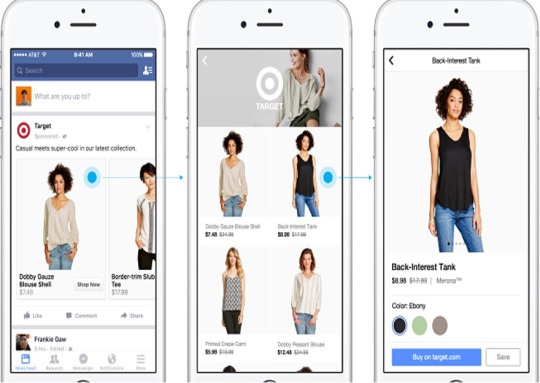
Here you can see just how easy it is for users to shop on Facebook, save items they are interested in, and head straight to the company’s website to make a final purchase.
Platform #2: Instagram
Instagram is another platform that feels like it’s non-negotiable.
Maybe it’s because it’s owned by Facebook, or maybe it’s because it also has another 1 billion users.
To determine if Instagram will be one of the best social media platforms for your business, let’s look at the demographics.
If you’re targeting a younger demographic, Instagram will be great for you.
72% of all teenagers use Instagram and 67% of all young adults under the age of 30 use Instagram.
You will also find about half of the people under the age of 50 years old on Instagram, and even a quarter of people between the ages of 50-65 on Instagram.
Because of the younger demographic of Instagram users, there are fewer users with college education and high income compared to Facebook.
Only 43% of people with college degrees use Instagram, and only 42% of high-income earners use Instagram on a daily basis.
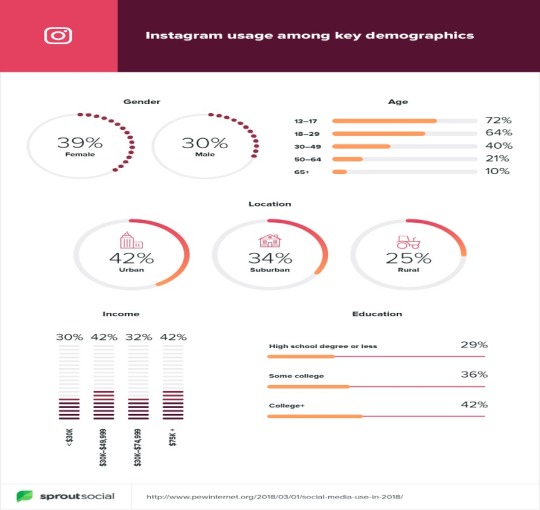
Because of the younger demographic of Instagram users, there are fewer users with college education and high income compared to Facebook.
Only 43% of people with college degrees use Instagram, and only 42% of high-income earners use Instagram on a daily basis.
Because of this, some professionals believe that while Instagram is an exciting platform, you will often find yourself competing for “cheap attention”.
Basically, people are mindlessly scrolling on Instagram and in order to be successful, you’re going to have to be very engaging to capture people’s attention.
Ultimately, Instagram is a great platform to reach consumers at large, but it may not contain the most sophisticated audience for specific industries, like engineering or information technology, for example.
Best Features for Your Business
Instagram’s unique social media platform can provide some powerful benefits for your business. One of the best benefits of Instagram is that it allows you to tell your brand’s story with unique and engaging visual content. Unlike other social media platforms, Instagram is heavily focused on visuals, both images and video. No matter what industry your company is in, you can use Instagram to showcase your products and tell your brand story in a way that’s visually appealing.
One interesting feature that can be useful is Instagram stories. With Instagram stories, you can take live video and share it with all of your followers. With this feature, you can easily provide behind-the-scenes footage of your business and share important news and updates with your followers.
Like Facebook, Instagram also allows you to message users directly. This can be a great tool for customer service. For instance, if a consumer finds you on Instagram and has a question about your products or services, they no longer have to navigate to your website or pick up the phone to ask. Instead, they can direct message you through Instagram, which allows you to answer questions and address concerns instantly. If this excites you, Instagram may be your best social media platform for business.
Platform #3: LinkedIn
LinkedIn got its start as a business and employment-based social media platform.
It’s full of professionals across a wide-spectrum of industries, especially B2B companies.
LinkedIn currently boasts just over 300 million users are active on a monthly basis.
So, in terms of audience size, it’s 4x smaller than Facebook, and 2x smaller than Instagram.
However, this fact is actually correlated with a major strength behind LinkedIn – it’s news feed.
Because LinkedIn’s newsfeed is not as competitive as other giants like Facebook and Instagram, businesses are able to reach more of their connections and followers without paying for advertisements.
For context here, because Facebook and Instagram news feeds are so crowded, they rely on specific algorithms and rules to determine if they will actually show your content to your followers.
I know, crazy right? I mean, you’d think that people who chose to follow you would automatically see your content. But no, it simply increases their chances of seeing your content on those platforms.
Anyway, the cool thing about LinkedIn is that it is not as stingy with its news feed. Not yet anyway. Which provides businesses and professionals an opportunity to build massive awareness and engagement on their platform.
Now regarding LinkedIn’s demographics, here are some noteworthy things.
LinkedIn is mostly used by professionals between the ages of 30-49 years of age. However, about a quarter of professionals above the age of 18-29, which I’d really say 22-29 use LinkedIn. As well as another quarter of people between the ages of 50-64 that use LinkedIn on a daily basis.
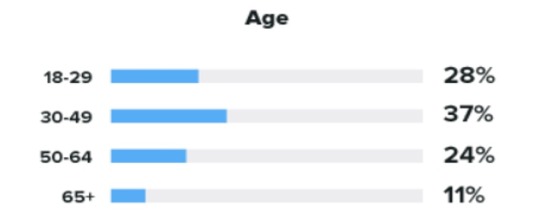
As mentioned earlier, LinkedIn does have a high-income audience. About half of people making over $75,000/year use LinkedIn on a regular basis.
In addition, about half of people with college degrees use LinkedIn on a regular basis, probably searching for their next job opportunity or seeking to consume professional content.
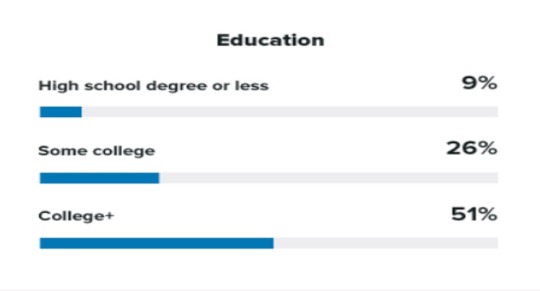
Best Features for Your Business
One of the best qualities of LinkedIn is that audiences on this social media platform are business-minded. This means that they are often open to networking opportunities and hearing about ways to improve the way they work or make their job easier. This provides an excellent opportunity for B2B brands that would like to connect with business decision-makers across different industries.
Another feature that makes LinkedIn one of the best social media platforms are the digital advertising opportunities. Though digital ads on LinkedIn may be more expensive than ads on Facebook, this ad opportunity allows B2B brands to reach individuals from the specific industries that they are targeting. Similarly, LinkedIn allows you to deliver ad content to those with the job roles that are involved with making purchasing decisions related to a company’s B2B offering.
LinkedIn also has groups that users can join and participate in based on their industry, job function, or career interests. This provides an excellent opportunity for brands to drive real engagement with influencers and decision makers across different industries.
Ultimately, if you serve businesses or professionals, then Linkedin Marketing should definitely be in the running as a top-contender for social media platforms to choose for your business.
Platform #4: Twitter
With an average of about 330 million active Twitter users worldwide, this channel is yet another one of the best social media platforms.
Twitter is a real-time social media platform. It’s like sending text messages to the whole world.
And it’s one of the only social media platforms where you don’t necessarily have to a bunch of videos or photos to stand-out.
Tweets can be up to 280 characters, which allows you the ability to craft a short, sharp, and concise message.
And because it’s limited in characters, it forces you to be creative with what you have to actually say.
So what are the hard stats on Twitter? Here they are:
Twitter has over 330 million active users, so about the same as LinkedIn and once again nowhere near Facebook and Instagram.
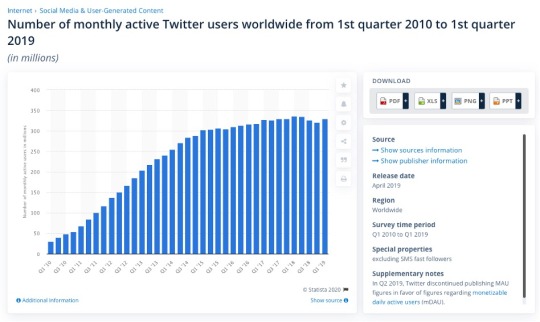
In terms of age, Twitter’s biggest demographic consists of people between the ages of 18-29. 38% of people in their category actively use Twitter, and surprisingly 32% of all teenagers use Twitter as well. You can also find about 26% of its users between the ages of 30-49.
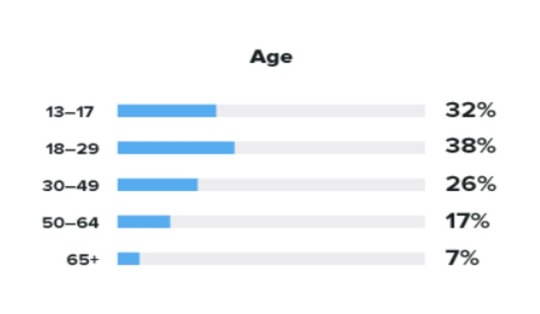
In terms of income and education, Twitter is not the highest on our list here. Only 32% of high-earners use Twitter regularly, and likewise, only 32% of people with college degrees use Twitter regularly.
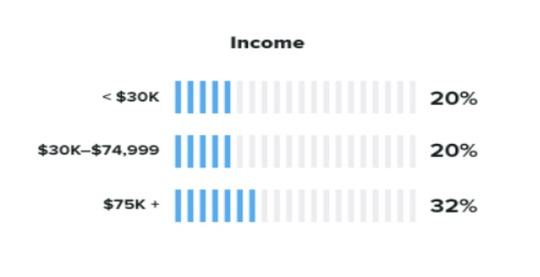
Best Features for Your Business
When it comes to Twitter, there are a few valuable features that may help it qualify to be one of the best social media platforms for business. Brands can use Twitter to reach and engage their audience. Hashtags allow you to follow and participate in conversations about trending topics in your industry. You can use hashtags to reach new audiences who might be interested in your content. Your brand can also take advantage of topics that are trending to expand your reach.
Twitter also offers advertising opportunities for companies that want to deliver digital ads to their target customers on the social media platform. They have multiple options for ad formats, depending on your unique digital advertising goals. You can promote your account, which will show up in the left column or promote a tweet from your brand, which will appear in the user’s Twitter feed. There is also the option to promote a certain trend that your company may be using to start a conversation among target users.
It’s also worth noting that Twitter is well-known for its search engine. Twitter’s search engine gets over 2 billion search queries per day, which may also help your demographic find your business while it’s searching for specific keywords and content.
Platform #5: Pinterest
Pinterest is a great social media platform with major search engine capabilities.
Most people use Pinterest to find inspiration or helpful content. For example, if you wanted to try a new cooking recipe, you could jump use Pinterest to find a food you’re interested in cooking.
While this is just an example, it’s really how most people use Pinterest. Pinterest is full of home decor, fashion, food, and most importantly, shopping.
Now, here are the stats.
Pinterest has over 322 million monthly active users.
And here’s a new stat we haven’t talked about on gender. Pinterest is mostly used by woman. In fact, there are 3x more women on Pinterest than men.
This shouldn’t concern you if your business fits. When it comes to purchasing decisions around fashion, home decor, and so on, women are the normally the predominant decision makers.
This is backed by the high-income profile that Pinterest has. 41% of people with high incomes use Pinterest on a regular basis.
And 38% of people with college degrees use Pinterest as well.
So if your business primarily targets consumers, especially women, then Pinterest is a hard platform to avoid.
Best Features for Your Business
One of the greatest aspects of Pinterest is that it has a significant reach among women across different demographics, including age, income, education level, and location.
This makes it the perfect platform for any brand with products or services that are targeting women. The image-focus of the platform also makes it ideal for brands in the fashion, home décor, art, food, or fitness industries.
The Pinterest Buy Button makes it easier than ever to sell products directly from your Pinterest page. Users can now conveniently search and pin products on Pinterest, and then, with the click of a button, they can add their favourite items to their shopping bag. This feature makes Pinterest another way for brands to gain visibility and increase sales.
Platform #6: YouTube
Last but not least, YouTube.
YouTube is arguably the best social media platform that exists.
For one, over 1.9 billion people use YouTube on a regular basis. This puts YouTube above Instagram and almost eye-to-eye with Facebook in terms of usage.
But not only is YouTube widely used, but it is also the 2nd largest search engine behind no other than Google.
So not only do you have the ability to reach a broad audience, but you are also able to reach people searching for you.
If we add all of this to the simple fact that video is the most preferred type of media amongst consumers, then YouTube becomes even harder to avoid.
So we have…
• Roughly 2 billion people use YouTube
• You can reach people searching for your content
• Video is the most preferred media format today
Then, what could possibly be wrong with YouTube?
Well, nothing is fundamentally wrong with it. But it takes a ton of work to get it work.
Not only do you need content, but you need an entire video setup with a camera, lighting, microphones and video editing.
YouTube is very effective, but production can be quite expensive if you want to stand out.
With that said, let’s look at some YouTube stats.
In terms of age, people of all ages use YouTube. 85% of teenagers and even 38% of people over the age of 65.
In terms of income, YouTube is heavily used by high-income search engine optimization individuals. 83% of people earning over $75K a year use YouTube regularly.
The same is true for education. 80% of people with college degrees use YouTube.
So in terms of the benefits of YouTube, is arguably the best social media platform for businesses. However, again, there is an astronomical amount of work involved to produce video after to video in order to be successful.
Best Features for Your Business
Perhaps the greatest perk of YouTube is that it allows brands to access an unlimited amount of video hosting. This makes it an affordable way for businesses to publish video content that can drive more engagement and influence conversions. YouTube content can also be easily integrated onto your website or shared on other social media platforms for greater reach.
Not only does YouTube allow you to reach a wide audience of viewers across the globe, but it can also help with your The content that you post on your brand’s YouTube channel is searchable in both YouTube and Google.
That means that Google may just serve your Youtube video content in its search engine results page for keywords that you are trying to target. Remember, it’s important to make sure that your Youtube videos are optimized if you want to get the most out of this helpful feature.
Need Help with Your Social Media Marketing?
Still not sure which channels are the best social media platforms for your business? That’s where we come in. Our social media knows just what it takes to help you grow your brand online. Through our social media we will help you plan and implement a social media management strategy that allows you to develop your brand awareness, build relationships, and increase website exposure through the social media that are right for your business.
2 notes
·
View notes
Photo

Drop a line for queries related to sales and growth & don't forget to follow for more! With such curated content, I aim to help beginners and people who await a positive change. Hope you found this post useful! 😇 Follow @crafxstudio & @phakkain for more content like this! #marketing #marketingdigital #marketingstrategy #marketingtips #marketingagency #nlp #nlppractitioner #nlpcoaching #kind #kindness #kindnessmatters #brand #branding #brandingquotes #brandingdesign #brandinginspiration #brandingagency #brandingstrategy #brandingtips #brandingstudio #graphicdesign #graphicdesigner #graphicdesigners #graphicdesigns #contentcreator https://www.instagram.com/p/CJvqs3ZFIn5/?igshid=ok9npk8jbxx7
#marketing#marketingdigital#marketingstrategy#marketingtips#marketingagency#nlp#nlppractitioner#nlpcoaching#kind#kindness#kindnessmatters#brand#branding#brandingquotes#brandingdesign#brandinginspiration#brandingagency#brandingstrategy#brandingtips#brandingstudio#graphicdesign#graphicdesigner#graphicdesigners#graphicdesigns#contentcreator
0 notes
Text
Marketing vs. Branding
Oftentimes, when people hear the word marketing, they don’t realize there’s a lot more under the surface that goes into “marketing” a business.
For example, there’s marketing and branding.
Branding, marketing.
Marketing vs branding.
The two are actually different and without distinguishing between them you won’t be able to recognize why you need both.
Ok, “what’s the difference and what do We need to know?”
What Exactly is Branding?
To be completely truthful, if you were to look up the answer online, the answer isn’t so clear…
According to Google, branding is the action of marking with a branding iron. And in the case of marketing, this doesn’t help us understand what branding really is.
But there is a 2nd definition that Google provides.
“Branding is the promotion of a product by means of advertising and distinctive design.”
Now when we look at this definition of branding, it more closely correlates to what we know about marketing.
Branding Mag refers to branding as “a marketing practice in which a company creates a name, symbol, or design that is easily identifiable.”
1) a marking
2) advertising and design and
3) a name or symbol
One consistency we can see here is that in all definitions, there is some element of creative design in it, whether it be a mark, symbol, or illustration.
But surely, branding is more than this, right? There has to be a reason why they didn’t just call this “art” or “graphic design.”
It’s because branding is much deeper than that. Branding is a BIG deal.
Branding is a person’s gut feeling about a product or service.
Branding is an emotion.
An emotion that someone has about your business.
It is how your brand information makes them feel when they first come into contact with it.
Brand goes way beyond a logo and business name. From your website, to your logo, to your social media profiles, to all marketing materials, the customer judges it all. Invest the necessary time and resources needed to develop a well recognisable brand! Contact us for all your Graphic design needs
The Important Points of Branding
As stated, branding is the FEELING that people have when they encounter your brand.
Branding is an art, not a science. It involves choosing the right symbols, messaging, and design in your company.
Even things such as color play a major role in your branding.
This is why understanding colors is also an important part of your branding strategy.
To do branding correctly for your business, you can use a website like Brand Personalities to identify your brand archetype.

Basically, this is a character that defines your brand’s personality. It takes a ivatar and who you’re trying to resonate with.
Therefore, be sure to carefully construct your branding with brand archetypes and your customer in mind.
But branding is bigger than this.
EVERYTHING your business does has a branding impact.
That’s why establishing a good brand image is crucial for not only big businesses, but also small businesses just entering the market.
Your marketing, your solutions, and ESPECIALLY your reputation are all important.
You can have a great brand design but still have horrible branding.
Just take McDonald’s for example.

McDonald’s branding is pretty good.
With their logo “The Golden Arches” and their use of fun-loving characters, they have managed to create a brand image that appeals heavily to their audience.
In addition, they’re playful, spontaneous, and funny. This is evidenced by their Instagram page.
McDonald’s is very consistent in their brand archetype, color scheme, and messaging and everything with their branding just makes sense.
Marketing vs Branding: Why Do You Need Them?
Marketing is more of an overarching umbrella that encompasses other aspects.
Branding is a subset of marketing.
It is an aspect of marketing, but is not the only thing marketing is concerned with.
For instance, marketing also includes advertising. And many times people also think these two terms are interchangeable.
But in actuality they are not. Marketing’s primary focus is to communicate your value to customers.
Branding is simply one of the ways marketing communicates to your customers, but is not the ONLY way to communicate.
Your Product and Solutions communicate value.
Pricing communicates your value.
Your advertising and promotion channels communicate your value.
Your website and geographic location also helps you to communicate with your customers.
Branding helps you present your marketing message in the best way possible to aid marketing in its attempt to communicate with your customers.
You can’t market bad branding. It doesn’t work that way.
A great marketing value proposition with a crappy website, blurry logo, and weak messaging can be more harmful to your business than helpful.
Both, marketing and branding, depend on each other in order to be effective.
Thus, it’s not really Marketing vs. Branding, but instead, Marketing AND Branding.
As we mentioned in the beginning, to really communicate your business message in the best way possible, you need the two to work together.
Simply trying to have one without the other isn’t something we recommend.
As mentioned before, marketing is the bigger umbrella, so there is a lot more to it than we can fit in this blog.
In other news, let’s go ahead and recap everything we’ve discussed in this blog so you can start working on your branding strategy!
Brand matters. A whole lot.
Make smart, tactical brand decisions and don’t underestimate the power of good graphic design. Connect with us for all your graphical needs!
Marketing vs Branding
What is the difference between marketing vs branding?
Branding is the FEELING people associate with your business.
While marketing helps COMMUNICATE that FEELING and ultimately, your business’s value proposition to your ideal customer.
When it comes to branding, it’s important for you to keep in mind that EVERYTHING your business does can impact your branding.
Yes, your logo and design are important . But none of this matters if your customers aren’t happy and you have a terrible reputation.
So, you need great marketing to supplement your branding.
Likewise, great marketing with HORRIBLE branding won’t do you any good either.
No one will buy from a business they don’t trust, or that flat-out looks unprofessional.
So the best solution is to carefully build both, your brand and your marketing – together.
Having a marketing plan in place will help you to better communicate your message to your audience.
You can invest in web design, search engine optimization.These are all major online marketing solutions that can help your business utilize.
Would you appreciate more tips on how to integrate digital marketing strategy? Contact us today to begin building your business.
1 note
·
View note
Text
Influencer Marketing Tools and Tips to Grow Your Brand
To have a successful e-commerce platform, you have to pay to play. Some of the Top brands spend billions to secure their Internet advertising space.
If you can’t keep up with the big companies that spend billions of dollars on their advertising campaigns, there are still a few ways you can get your brand noticed.

One such method is an influencer promotion campaign. It’s a quick and effective way to help with brand recognition. You could also invest in some tools that will make working with influencers simpler. In this guide, we will break down these unconventional forms of marketing.
To award your Brand a Prime Recognition connect here
How Using Social Media Influencers Can Grow Your E-commerce Brand
Influencer Marketing is the practice of working with well-known social media users to grow your brand. For example, if you have a popular skincare line, you might have a well-known lifestyle influencer try your product and tell their audience about their results.
This is a highly effective strategy. In fact, 49% users say they rely on recommendations from influencers on Twitter to make purchase decisions.
Marketers like influencer promotions too. Nearly 89% marketers say that influencer marketing campaigns’ ROI is the same or better than other marketing channels like SEO or PPC.
The problem is, most e-commerce brands don’t have the budget to partner with the major influencers.
Working with micro-influencers, who have smaller but more targeted audiences, might be the way to go. However, you still have to deal with finding the right influencers, managing communications, making sure influencers create the posts you pay them for, and tracking campaign efficacy.
For smaller e-commerce stores or those with limited budgets, this can be more hassle than it’s worth.
So what’s the answer?
Try using influencer marketing tools for e-commerce brands that make working with influencers easier by bringing the influencers to you.
Why Your E-Commerce Business Should Use Influencer Marketing Tools
E-commerce is a highly competitive market. Currently, there are more than 7 million online retailers. That’s a lot of other stores for users to choose from.
For e-commerce brands, influencer promotion helps leverage your consumer base to do your marketing for you rather than spending thousands on ads that may or may not actually work. Influencer marketing tools can help connect you with hundreds of powerful influencers.
In addition, influencer marketing tools often offer marketing tools such as automated emails that reduce other e-commerce challenges, like cart abandonment.
Here are a few other benefits of influencer marketing tools for e-commerce brands:
· Letting the influencer choose the brand or product means the person using your product is more likely to be genuinely interested in it. This makes their content more authentic.
· Tools give you access to a wider range of influencers instead of focusing on who you already know, including micro-influencers.
· Influencer tools can help you track influencers’ niches, the quality of their audiences, and their engagement rates so you know the influencers you work with are legitimate.
· Tools that take care of all communications, post content, and monitoring, thereby simplifying the process, meaning brands can sit back and enjoy conversions without the hassle of striking and sealing deals.
By using influencer marketing tools, consumers can get a good deal and value for their money. The added incentive of discounts has the potential to attract new customers by drawing them in with savings and payment options.
Influencer Marketing for E-Commerce: Tools to Help Grow Your Brand
Brands have stepped into the scene and are finding creative ways to leverage consumer marketing techniques.
SwayPay
SwayPay offers discounted rates for influencer promotion, which can offset added costs like shipping, tax, and fees. In addition, SwayPay offers a simplified payment option that tailors itself to consumer needs.
As users browse through online stores, they see special SwayPay pricing available on products. When they go to purchase a product, they will be asked to add their Instagram account handle. Adding this information lets them know what discounts they may be eligible for and how many Instagram posts will be required to earn the discount.
A user’s “sway” determines their discounts, which means the more followers they have, the less they have to pay. This ensures the posts you are trading for will benefit your business, not simply fade out into the social sphere.
In the SwayPay checkout, the user will pay the full dollar amount of the product, without the discount. Then, they have 30 days to make the required posts and keep their discount.
This means a shopper could pay for a $150 item with $90 and two Instagram posts. SwayPay requires shoppers to tag them in each post, so compliance is mandated.
Looking for more ways to improve your website? Find out how you can drive 10 times the sales within your budget. Click here to know more!

For businesses, this system opens up a range of new conversion opportunities. Customers are now incentivized to complete their purchase and engage in online marketing of the product.
The SwayPay app boasts their retailers receive twice the number of branded Instagram posts, 17% engagement increases on SwayPay posts, and up to 13% of all processed sales coming through their app.
Currently, the app only works with Shopify and Instagram. They are hoping to branch out in the coming quarters and integrate their platform with the likes of TikTok and BigCommerce.
SwayPay plans to introduce more ways to sway, such as a SwayScore that would score user purchases and reward them with extra discounts or prizes. They also plan to implement a Live Receipt feature to let users generate sales more directly through affiliate payments.
At the moment, SwayPay offers the best ease and accessibility for consumers. Seeing the discount at point-of-purchase as well as a clear and direct promotion task is unique and, if their strategy works out, will help brands connect with influencers more often and more efficiently.
Dealspotr’s Influencer Marketplace

Dealspotr is an online platform that connects influencers to brands and offers discount codes through their website. They call themselves “the LinkedIn of influencer marketing” and are essentially a meeting place for brands and influencers.
Brands can offer “free product campaigns” that supply products directly to influencers, or they can choose a “promotional fee campaign”, where they pay influencers a designated rate in exchange for promotions.
This gives brands greater visibility without having to find the right influencers and adjust the process based on what works best for your brand. For example, you can offer influencers an exclusive discount code for their followers or partner with specific influencers that fit your niche.
You can fund an influencer campaign with as much or as little as you like, though Dealspotr does recommend offering at least $100 if you want to work with small to medium-sized influencers.
Unlike SwayPay, Dealspotr doesn’t offer a point-of-sale option. That means their customers can set up deals on the platform but will have to find workarounds to get those discounts applied to their orders.
Heepsy

Heepsy is an influencer search and marketplace that connects brands with more than 11 million influencers on sites like Instagram, YouTube, TikTok, Twitter, and Facebook.
Like other influencer tools for e-commerce, Heepsy makes it far easier to connect with influencers. In addition, Heepsy provides data about influencer audiences, engagement rates, and gives influencers an “authenticity score.”
You can also create influencer lists, make sure they don’t have a ton of fake followers, and even monitor the effectiveness of campaigns.
All this data makes it easier to find the right influencers for your e-commerce brand — and make sure your influencer campaigns are driving sales.
If you don’t want to deal with managing the influencer process, Heepsy can handle it for you with their influencer campaign management service.
Shopify

Shopify is best known as an e-commerce solution for building stores. However, there’s a lesser known tool you can use with influencer marketing as well.
Shopify also offers group discounts, which can help you create special rates for your influencer community. By using the code, influencers can receive a predetermined commission based on your agreement.
You can also add influencers to a specific customer group so that no one else can use that code — which protects you from giving deep discounts to everyone if the code gets leaked.
While not as full-featured as some of the other influencer marketing tools (there are no pay features or influencer marketing metrics, for example), this is an easy way to leverage influencer marketing if you already have a Shopify account.
Conclusion
As the popularity of e-commerce continues to grow, finding cost-effective advertising platforms will become more and more important.
You can offer customers discounts on products in exchange for Instagram posts. These posts act as influencer marketing channels and allow your products to be seen by more people, more often.
By offering discounted rates, which research says improves buying behaviors, you open up your market to new customers.
Likewise, tapping into influencer promotion is a great way to spend less on advertising and keep your budget where you want it to be.
What benefits have you found through influencer marketing for e-commerce?
These were few examples of how you can get your brand recognition but there are many more ways to do it. The importance is that you actually do it. To break this into action contact us today!
#influencer#tip#brand#marketing#influencer marketing#growth#advertising#instagram tools#instagram#influenza#ecommerce
1 note
·
View note